Traffic calming uses physical design and other measures to improve safety for all road users. It is used to reduce speed and enhance a safe street environment for non-motorists.
Speed bumps
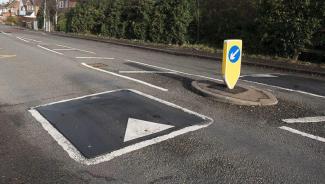
Speed cushions (also known as speed bumps) can be an effective way to reduce speeds.
A speed cushion is a short raised rounded section of road in the centre of a road lane.
It’s like a speed table but has a raised section with a gap between them.
Speed tables are more effective than speed cushions in reducing speeds. Speed cushions allow wider vehicles to straddle the cushion allowing buses and emergency services to pass along a route.
Speed cushions are designed to be wider than a car so car drivers will need to slow down and drive over the centre of the cushion to reduce discomfort.
However, they aren’t an appropriate form of traffic calming for entry speeds as they can result in late braking and a risk to motorists losing control. Speed cushions may create noise and vibration which could impact local residences.
The presence of speed cushions may cause traffic to divert to other routes.
To meet the Department for Transport’s (DfT) guidance, multiple sets of cushions need to be installed on each approach. Installing speed cushions in residential areas requires suitable street lighting throughout.
Due to the impact on pollution, central government is looking for local authorities to reduce the use of speed cushions. This includes removing them where appropriate which would make it harder to justify installation.
Speed tables
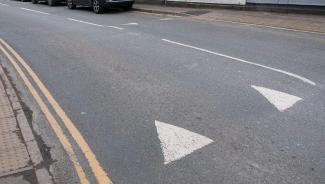
Speed tables are also known as junction tables when placed at a junction and take the form of a raised section that spans the road.
They achieve significant reduction in speed, making it easier and safer for pedestrians to cross the road on the top of the table where speeds are at their lowest.
Traffic calming techniques work best when they're installed as a series of tables along a length of a road rather than at one single point.
Speed tables may create noise and vibration which could impact local residents.
They may cause traffic to divert to other routes, where a route is regularly used by larger vehicles and/or trailers. Therefore, careful consideration would be given to their location.
Drainage impacts would also need to be considered in the design of a speed table.
Priority narrowing
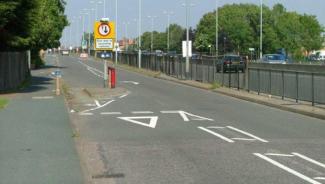
Priority narrowing involves introducing road narrowing which creates a one-way priority system at that point.
The speed reducing effect relies on the regular presence of oncoming vehicles. Traffic without priority has to periodically give way and consequently reduces its speed.
Success with priority narrowing and priority chicanes can be difficult to achieve. Their placement depends on good visibility from approaching drivers. The presence of private drives and side roads also restrict the opportunities where priority narrowing can be placed.
Priority chicanes
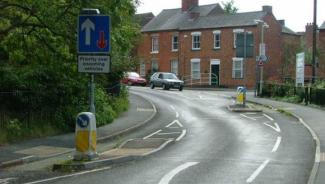
Priority chicanes can take the form of a set or various sets of carriageway narrowings.
Groups of chicanes are normally placed with alternating priority along a road, so that each direction of vehicle traffic may have to stop and give priority in equal amounts.
The narrowing(s) can allow two-way traffic flow or can give priority to drivers travelling in a certain direction like with priority narrowing.
The aim of chicanes is to break up the traffic flow and so reduce vehicle speeds.
Success with priority narrowing and priority chicanes can be difficult to achieve. Their placement depends on good visibility from approaching drivers. The presence of private drives and side roads also restrict the opportunities where priority narrowing can be placed.
Priority chicanes don’t cause any vehicle passenger discomfort in comparison to vertical treatments. Also, some designs may allow cyclists to bypass them.
Vehicle activated signs (VAS)
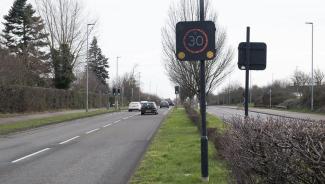
Vehicle activated signs (VAS) are electric signs which display a message or speed when triggered by vehicles travelling at excessive speeds.
The signs can display the speed limit or they can warn drivers of an approaching hazard.
VAS supplement rather than replace the traditional signs and line and address specific road safety problems.
A vehicle activated sign should be used strategically where they will have the maximum effect.
The on-going maintenance will need to be the responsibility of a Third Party.
Sign may require electrical connection or be solar power operated where electrical connection is not possible.
Mobile vehicle activated sign (MVAS)
The Mobile Vehicle Activated Sign (MVAS) scheme is an option for areas or parishes within Leicestershire that wish to have an ongoing method of addressing excessive speed in their community.
MVAS units are usually battery operated and display either the speed at which the approaching vehicle is travelling or give a reminder of the speed limit. Subject to the agreement of the county council, MVAS units can be mounted to existing metal lamp posts (not concrete or telegraph posts). Alternatively, Leicestershire County Council can install new posts at agreed locations, specifically for MVAS use.
Best use of MVAS
MVAS works best when the unit can be moved between several locations. A good option is one MVAS unit to four locations. This has the advantage of drivers not becoming over familiar with the unit’s location. Extra mounting brackets can be left in place to make the process of moving the MVAS between locations as easy as possible. A minimum of two locations is required for consideration of MVAS.
Cost of units
An MVAS unit typically costs £3000 (with additional costs for extra batteries and brackets). The purchase of any unit is made directly with a supplier and not by Leicestershire County Council.
There are also additional costs for any:
- lamp post safety inspections
- new posts that need to be installed by the county council (if applicable)
- fees for licencing agreements, which are required for all MVAS schemes on the public highway.
Setting up an MVAS Scheme
If your community is interested in buying an MVAS, the application should be made from a parish council (due to insurance requirements and legal agreements). The parish council can make the application via their usual contact methods.
The following steps will need to be discussed:
• a map provided showing the locations where an MVAS is proposed
• discussing the preferred supplier and MVAS specification
• agreeing install requirements with existing or new posts
• costs and fees involved with install and legal agreements.
For other similar/complimentary schemes, please see Community Speed Watch – a free scheme operated by community volunteer groups.
Rumble strips

The use of rumble strips (transverse bar markings) is designed to provide a visual, sensory warning to drivers on high-speed approaches to roundabouts and high accident frequency locations.
When used in the correct layout, rumble strips have been proven to be very effective against accidents associated with excessive speeding.
These normally take the form of a series of slightly raised strips of different coloured surfacing, set across the width of the road.
The appearance and feel of the strips are intended to cause drivers to reduce their speed.
Due to the resulting road noise which can be experienced by nearby residents, the locations where rumble strips can be effectively used are limited.
Rumble strips are not normally laid within 300 yards of residential properties.
Carriageway roundel

Carriageway roundels are hardwearing markings that indicate the speed limit on the carriageway.
Speed limits state the maximum speed permitted on a given road.
The speed limit is displayed at the beginning of the section of road, inside a circular sign.
The marking is varied to show the speed limit in force and elongated in the direction of travel to compensate for the foreshortening effect.
Carriageway roundels can’t be:
- used as a repeater in a street lit area
Carriageway roundels can be:
- used as a repeater for 20, 40 and 50mph speed limits (not to be used on 30mph speed limits).
Carriageway roundels are normally installed in pairs co-located with a terminal sign at the start of a speed limit.
20mph speed limits and zones
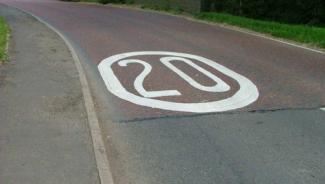
A 20mph speed limit consists of a speed limit change, indicated by signage.
Speed limits as low as 20mph should normally be introduced with extensive traffic calming measures (e.g. speed tables, and speed bumps) to ensure that speeds are in compliance with the limit, or where speeds are already low.
Signs are places on the road surface with repeater signs on lamp columns.
All relevant factors must be taken into account when considering the appropriate speed limit for any given road, other factors must be assessed as installing the wrong speed limit on a road will mean it won’t work properly. The speed limit must be appropriate, taking into account all the road’s characteristics and the surrounding environment, such as whether the locality is built up area, near a school or a town centre.
20mph zones have generally been considered in residential areas to keep speeds low.
Footway build-outs
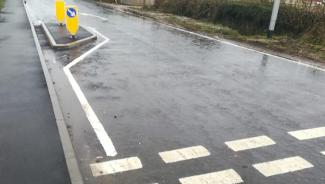
A build-out is a section of kerb/footway extended out into the carriageway on one side only to narrow the road.
This can reduce crossing distances and improve visibility for pedestrians.
If the space is available, a gap can be left between the pavement and the build out to form a cycle bypass.
It is particularly beneficial near parked cars (see sheltered parking) but can also be used as part of a chicane system (see priority chicanes and priority narrowing above).
Build-outs can be difficult to achieve where there are many private driveways restricting their positioning.
Village gateway
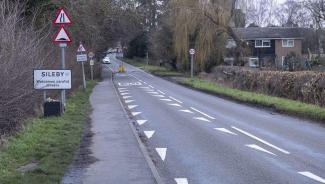
Village gateways are usually found on the approaches to built up areas where the speed limit signs and town or village nameplates can be incorporated to alert approaching drivers.
The signs may be placed on high profile backing boards and when introduced with new road markings, remind drivers that they are entering an area which requires extra special attention.
A road traffic message may also be included with a maximum of 5 words.